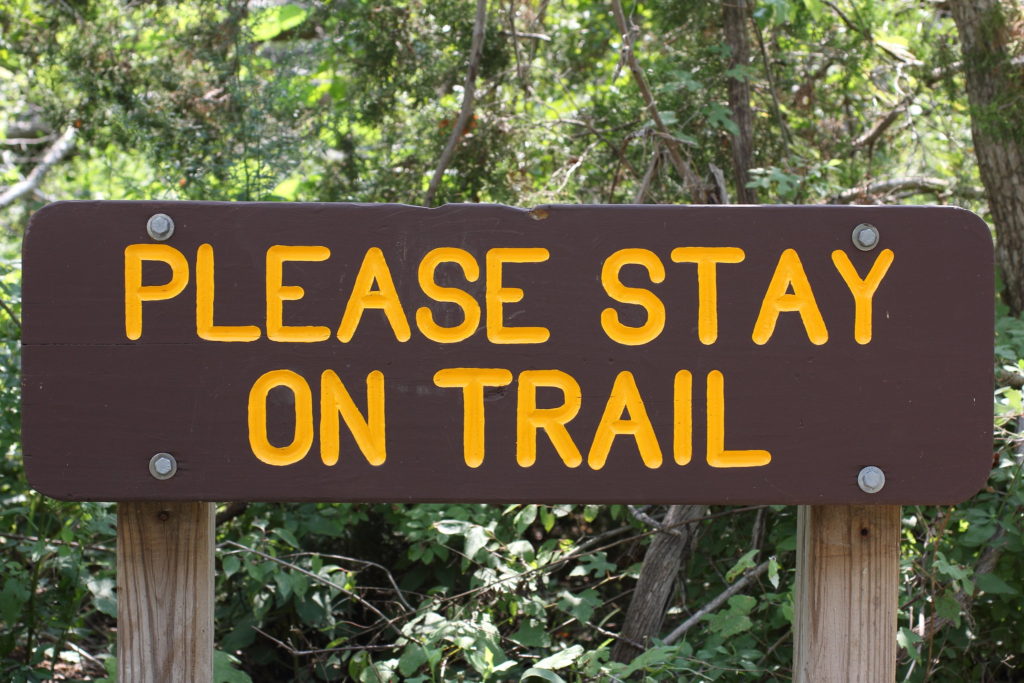
Any trip in the outdoors carries risks to your health and safety. Be sure to understand these risks, prepare and act properly to minimize them, and accept these risks before using any of the hikes presented on this site.
Stay on the Trail – When following a GPS track while hiking, remain cognizant of the fact that GPS tracks are inherently inaccurate; they may be 30-50 feet (or more) off the actual trail. Do not blindly follow the track; only use it as a rough guide to keep on the trail. If the trail becomes impassible or you are uncertain how to proceed, retrace your steps back to the starting point. Do not bushwhack through the woods – this will dramatically increase your risk of injury. Similarly, when you are looking for a plant or animal as part of a scavenger hunt, you may be tempted to leave the trail to search the surrounding area. Resist this urge - our scavenger hunts and other activities are designed to be completed on the trail.
Be Aware of Trail Conditions – The trails in certain parks may not be well-maintained, and may be overgrown or disappear altogether over time. This is especially true of trails in Wildlife Management Areas and State Forests, which receive little attention during non-hunting seasons. If a trail cannot be easily followed, abandon the hike and return to your starting point. Otherwise, you will expose yourself to greater risk of injury and unwanted wildlife encounters (especially tick bites). In addition, the tracks in our trail collections may be unreliable, since they are often based on older trail experiences or maps. Our trail guides are not intended as a substitute for an official park trail map. Always compare the tracks in a guided hike or a trail collection to a current trail map for the park and discard those that seem outdated. It is usually wise to have a second, nearby hike on your smartphone to use as a backup walk in case your first choice does not pan out. Again, do not bushwhack through the woods to try to force your way through on an unclear path – go back.
Avoid Hunting Areas in Season – Some public lands such as Wildlife Management Areas and State Forests allow hunting during certain times of the year. It is best to avoid these areas at those times in order to minimize the risk of accidents. Therefore, you must know whether hunting is allowed at your destination park and whether the hunting season is active at the specific park at the specific time you plan to visit. Always check the park Web site for current hunting schedules. See our section Know Hunting Locations and Seasons for more information.
Visit Park Web Site and/or Contact the Park Office – Check the park web site for any alerts and safety warnings, and call the park office (if available) for additional information.
Bring a Paper Map – Before you go, print off a paper map from the park Web site or our site. This will give you an alternative way to navigate if your smartphone should become disabled for any reason. If necessary, retrace your steps back to the starting point.
Keep Your Head Up – Always stop before consulting your smartphone while walking. This way, you can stay alert to any obstacles or hazards on the trail.
Do Not Interact with Wildlife – Observe all wildlife from a distance, and do not touch or otherwise interact with any plants or animals.
Bring an Extra Battery – GPS apps place a drain on your smartphone battery. Extended use of these apps may deplete your battery in a matter of hours. It is wise to invest in an extra battery to carry with you, making sure it allows you to use your phone while charging.
Use Insect Repellent and Sun Screen – Besides being uncomfortable, insect bites can transmit diseases. Be especially mindful of ticks.
Beware of Stream Crossings – Some trails may require the crossing of small streams with or without a bridge. Do not attempt these crossings during periods of high water and/or low temperatures, and always wear boots.
Use the Buddy System - It is always best to hike with one or more companions in case of injury or some other mishap. Make sure to notify friends and/or family of your whereabouts for the hike.
Bring Water – Make sure you stay hydrated, especially on hot days.
Pay Special Attention to Children – If any children are along for the hike, be sure to review safety rules with them ahead of time, and choose hikes that pose fewer dangers. Avoid hikes that include rough trails, steep cliffs, deep running water, and other obvious safety issues.
Review the Weather Forecast – Avoid hiking when there is a threat of thunderstorms or other weather hazards. Be sure to check the forecast for your specific destination if it is far from your home. Apps such as Storm Radar can show you approaching storms while on the trail (assuming cell coverage for an Internet connection). If you hear or see a thunderstorm while hiking, hustle back to your car or find shelter nearby.
These safety tips are just reminders of the most important safety measures. If you are new to hiking, be sure to visit the American Hiking Society’s page. This site will prepare you for your hiking adventures.
